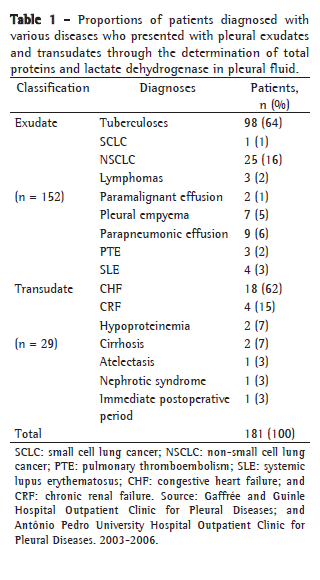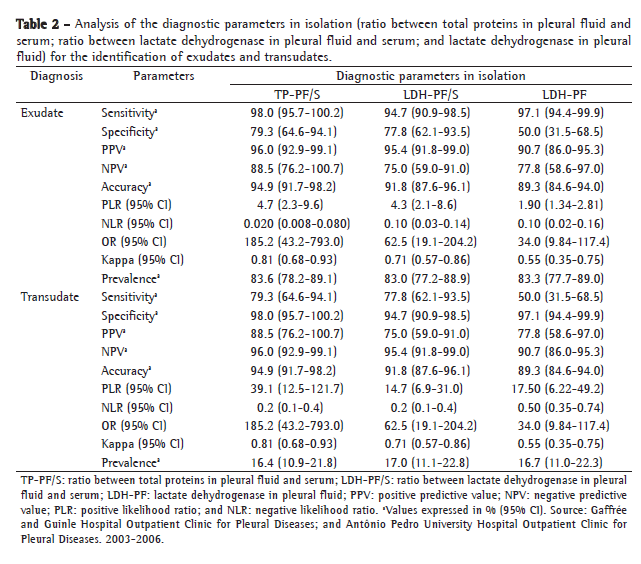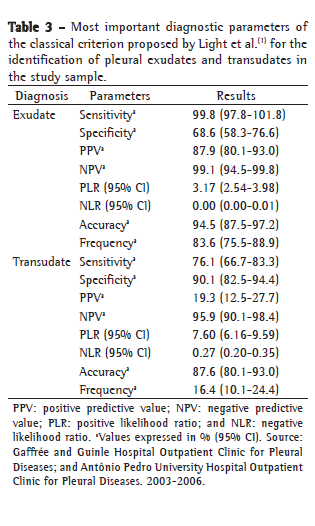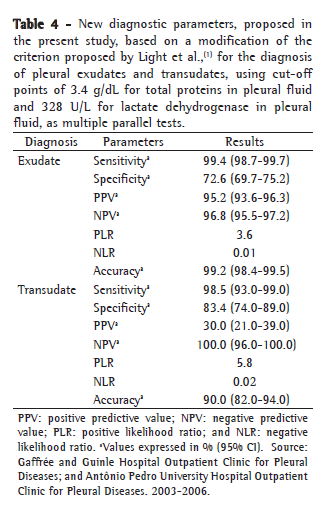ABSTRACT
Objective: To propose a new classification criterion for the differentiation between pleural exudates and transudates-quantifying total proteins in pleural fluid (TP-PF) and lactate dehydrogenase in pleural fluid (LDH-PF) exclusively-as well as to compare this new criterion with the classical criterion in terms of diagnostic yield. Methods: This was an observational, cross-sectional study with a within-subject design, comprising 181 patients with pleural effusion treated at two university hospitals in the state of Rio de Janeiro, Brazil, between 2003 and 2006. The diagnostic parameters included in the classical criterion were identified, as were those included in the new criterion. Results: Of the 181 patients, 152 and 29 were diagnosed with pleural exudates and pleural transudates, respectively. For the classical criterion, the sensitivity, specificity, and accuracy for the diagnosis of pleural exudates were, respectively, 99.8%, 68.6%, and 94.5%, whereas the corresponding values for the diagnosis of pleural transudates were 76.1%, 90.1%, and 87.6%. For the new criterion (cut-off points set at 3.4 g/dL for TP-PF and 328.0 U/L for LDH-PF), the sensitivity, specificity, and accuracy for the diagnosis of exudates were, respectively, 99.4%, 72.6%, and 99.2%, whereas the corresponding values for the diagnosis of transudates were 98.5%, 83.4%, and 90.0%. The accuracy of the new criterion for the diagnosis of pleural exudates was significantly greater than was that of the classical criterion (p = 0.0022). Conclusions: The diagnostic yield was comparable between the two criteria studied. Therefore, the new classification criterion can be used in daily practice.
Keywords:
Pleural effusion/diagnosis; Pleural effusion/classification; Exudates and transudates.
RESUMO
Objetivo: Propor um novo critério de classificação para a diferenciação entre exsudatos e transudatos pleurais através da dosagem de proteínas totais no líquido pleural (PT-LP) e de desidrogenase lática no líquido pleural (DHL-LP) exclusivamente, assim como comparar o rendimento diagnóstico entre esse novo critério com o critério clássico. Métodos: Estudo observacional, transversal de tipo individualizado, no qual foram selecionados 181 pacientes com derrame pleural tratados em dois hospitais universitários no estado do Rio de Janeiro (RJ) entre 2003 e 2006. Os parâmetros diagnósticos incluídos no critério clássico, assim como os do novo critério, foram determinados. Resultados: Dos 181 pacientes, 152 e 29 foram diagnosticados, respectivamente, com exsudato pleural e transudato pleural. A sensibilidade, especificidade e acurácia do critério clássico para o diagnóstico de exsudato pleural foram, respectivamente, de 99,8%, 68,6% e 94,5%, enquanto, para o diagnóstico de transudato pleural, essas foram de 76,1%, 90,1% e 87,6%. Utilizando-se os pontos de corte de 3,4 g/dL para a dosagem de PT-LP e de 328,0 U/L para aquela de DHL-LP (novo critério), a sensibilidade, especificidade e acurácia foram de, respectivamente, 99,4%, 72,6% e 99,2%, para o diagnóstico de exsudato, e de 98,5%, 83,4% e 90,0%, para o diagnóstico de transudato. A acurácia do novo critério proposto para o diagnóstico de exsudato pleural foi significativamente maior que aquela do critério clássico (p = 0,0022). Conclusões: O rendimento diagnóstico dos dois critérios estudados foi semelhante. Portanto, esse novo critério de classificação pode ser utilizado na prática diária.
Palavras-chave:
Derrame pleural/diagnóstico; Derrame pleural/classificação; Exudatos e transudatos.
IntroductionDespite the increasing search for parameters of pleural fluid analysis that can diagnose the cause of plural effusion, no strategies devised to date have been able to escape the initial question that must be posed when this highly prevalent condition is encountered: "Is the pleural fluid an exudate or a transudate?" In order to answer that question, many investigators have employed the criterion proposed in 1972 by Light et al.,(1) which shows good sensitivity but less than satisfactory specificity. This classical criterion defines exudative pleural effusions as those in which the ratio between total proteins in pleural fluid (TP-PF) and total proteins in plasma is > 0.5, lactate dehydrogenase in pleural fluid (LDH-PF) is > 200 U/L, and the ratio between LDH-PF and serum is > 0.6. Subsequently, LDH-PF higher than two thirds of the normal serum level of LDH was also considered to be indicative of an exudate. In recent years, certain biochemical markers have been tested and compared with the Light et al. criterion in order to determine which marker presents the best discriminatory power to distinguish between these two broad categories of causes of pleural effusion.(2) However, the ideal criterion has yet to be fully defined, although it should be borne in mind that combining criteria and tests can improve the diagnostic accuracy.
It is accepted that the cause of pleural effusion can defy definition, which occurs in approximately 20% of the cases.(3) However, the correct classification of pleural fluid as an exudate or a transudate is mandatory. The diagnostic yield of the test or tests must be satisfactory, because a transudate indicates a low likelihood of a specific pleural disease and an exudate indicates the opposite. When the initial evidence indicates an exudate, the investigation must continue because the preliminary interpretation will lead to the hypothesis of pleural disease, either primary or secondary to some other related disease.
In the present study, we applied the classical criterion (that proposed by Light et al.) to a sample of patients being treated at two university hospitals in the state of Rio de Janeiro, Brazil (the Fluminense Federal University Antônio Pedro University Hospital; and the Federal University of the State of Rio de Janeiro Gaffrée and Guinle University Hospital), between 2003 and 2006, with the principal objective of studying the diagnostic parameters of the criterion for discrimination between pleural exudates and transudates.
The specific objectives of the present study were to propose a new classification criterion for the differentiation between pleural exudates and transudates-quantifying TP-PF and LDH-PF exclusively-as well as to compare this new criterion with the classical criterion in terms of diagnostic yield (accuracy).
MethodsThis was an observational, cross-sectional study with a within-subject design and a focus on diagnosis. Patients were their own controls, and were diagnosed in accordance with the current criteria for the diagnosis of such diseases. To that end, we used a test panel designated pleural fluid analysis, which consisted of a sequence of routine tests followed by specific complementary tests that were performed based on the diagnostic possibilities identified by the routine tests. The final diagnosis of the each of the diseases found in the patients under study was based on the clinical evaluation recommended for the diagnosis of such diseases.
The determination of LDH and TP was the principal focus of the analysis.
The levels of LDH (U/L) in pleural fluid and serum samples were determined by a modified (optimized) kinetic method, whereas the levels of TP (g/dL) in pleural fluid and serum samples were determined by the classical biuret method.
Between 2003 and 2006, patients were selected in accordance with the following inclusion criteria: presenting with clinical and imaging profiles consistent with pleural effusion; and being under treatment at one of the outpatient clinics of the aforementioned university hospitals. In addition, we selected only those patients for whom the results of the pleural fluid analysis were conclusive regarding the cause of the existing effusion and were obtained by means of one or more of the following procedures: thoracentesis; Cope needle biopsy; thoracoscopy; and thoracotomy. The approach to the pleural cavity and the conservation of the material obtained followed the consensus technical norms.(4)
The patients gave written informed consent, and the study was approved by the Research Ethics Committee of the Fluminense Federal University School of Medicine (CEP/CMM/HUAP/UFF, no. 150/03).
We excluded pleural fluid samples from the following types of patients: those with hemothorax; those under anticoagulant, thrombolytic, or diuretic therapy; those with positive HIV serology; and those in whom the cause of the pleural effusion remained unknown despite exhaustive investigation. We also excluded pleural fluid samples found to contain fibrin, excessive lipids, or bilirubin.
Descriptive and inferential statistical analysis was carried out using the program MedCalc, version 9.3 (MedCalc Software, Mariakerke, Belgium). Values of p < 0.05 were considered sufficient to reject the null hypothesis. The ROC curve was used to calculate the reference value or the reactivity cut-off point for each test. In order to analyze the diagnostic or validity parameters of a given test with a 95% CI, we calculated the sensitivity, specificity, and accuracy of the determination of TP and LDH, as well as those of the predictive (or diagnostic) values of the TP and LDH tests, without Bayes' theorem. Positive and negative likelihood ratios were used as overall indicators of concordance. The chi-square test was used in order to compare the criteria in terms of accuracy. After the distribution of normality had been determined by the Kolmogorov-Smirnov test, nonparametric tests were performed to compare means and medians. In order to calculate the diagnostic parameters of the Light et al. criterion and those of the new criterion proposed in the present study, the tests that defined the parameters were used as multiple parallel tests, with the aid of rules for calculating the probability of independent events occurring in conjuction.
ResultsTable 1 shows the distribution of the causes of exudates (in 152 patients) and transudates (in 29 patients) in the cases under study.

In the group of patients with exudates, the mean age was 43.3 years (range: 9-43), and the male gender predominated (66.0%). In the group of patients with transudates, the mean age was 60.4 years (range: 35-89), and the male gender also predominated (52.3%).
Table 2 shows the analysis of the diagnostic parameters in isolation (ratio between TP-PF and serum [TP-PF/S]; ratio between LDH-PF and serum [LDH-PF/S]; and LDH-PF) for the identification of exudates and transudates. The sensitivity of the three tests for the identification of exudates was, respectively, 98.0% (95% CI: 95.7-100.2%), 94.7% (95% CI: 90.9-98.5%), and 97.1% (95% CI: 94.4-99.9%), whereas the specificity of these isolated measurements was lower than was their sensitivity, principally with regard to the determination of LDH-PF, the specificity of which was 50.0% (95% CI: 31.5-68.5%). The cut-off point for the determination of LDH-PF was, as recommended in the classical criterion, 200 U/L.

The variables under study had higher specificity for transudates than for exudates, the values of TP-PF/S, LDH-PF/S, and LDH-PF for the former being, respectively, 98.0% (95% CI: 95.7-100.2%), 94.7% (95% CI: 90.9-98.5%), and 97.1% (95% CI: 94.4-99.9%), as shown in Table 2. Table 2 also summarizes other parameters of the analysis regarding the diagnostic parameters of the tests studied in isolation.
Table 3 summarizes the most important diagnostic parameters of the classical criterion for the identification of pleural exudates and transudates in the study sample. In this case, the tests to determine TP and LDH were used as multiple parallel tests for the diagnostic index.

In order to establish the differential diagnosis between exudates and transudates, we determined the levels of TP-PF and LDH-PF. By means of the ROC curve, the best cut-off points for these tests were calculated by the program MedCalc. The accuracy of the tests according to each of these new cut-off points was determined based on the values of the area under the ROC curve.
Regarding the determination of TP-PF, the new cut-off point established for the differentiation between pleural exudates and pleural transudates was 3.4 g/dL (exudates > 3.4 g/dL and transudates ≤ 3.4 g/dL). The area under the ROC curve was 0.886 (p = 0.0001).
Regarding LDH-PF, the new cut-off point established for the differentiation between pleural exudates and pleural transudates was 328.0 U/L (exudates > 328.0 U/L and transudates ≤ 328.0 U/L). The area under the ROC curve was 0.922 (p = 0.0001).
After the multiple TP-PF and LDH-PF tests had been used in parallel, the new diagnostic parameters proposed in the present study-based on a modification of the Light et al. criterion for the diagnosis of pleural exudates and transudates-are shown in Table 4.

Finally, we compared the accuracy of the new criterion proposed in the present study (determination of PT-PF and LDH-PF as isolated parameters) with that of the classical criterion (Table 5). The diagnostic yield of the new criterion proposed for the detection of exudates was significantly higher than was that of the classical criterion. However, we found no significant differences between the two approaches in terms of the detection of transudates.
 Discussion
DiscussionIn the study sample, which comprised patients from two referral university hospitals, the predominant cause of exudates was infection (tuberculosis), possibly indicative of the situation in Brazil as a whole. This finding is in disagreement with those of other studies, such as the pioneering study conducted by Light et al.(1) and the study conducted by Hirsch et al.,(5) in which neoplasia was the principal cause of exudates, tuberculosis ranking third among the most common causes. In the present study, congestive heart failure was the principal cause of transudates, which corroborates the results of other studies in the literature.
In recent decades, studies have been conducted with the purpose of perfecting the differential diagnosis between transudates and exudates, aiming to find tests that can, in isolation or in combination, discriminate between pleural transudates and pleural exudates.(2)
In our study sample, the sensitivity, specificity, and accuracy of the classical Light et al. criterion for the diagnosis of exudates were, respectively, 99.8% (95% CI: 97.8-101.8%), 68.6% (95% CI: 58.3-76.6%), and 94.5% (95% CI: 87.5-97.2%; Table 3). When the classical criterion was used to diagnose transudates, the accuracy was lower. The sensitivity, specificity, and accuracy of the classical criterion for the diagnosis of transudates were 76.1% (95% CI: 66.7-83.3%), 90.1% (95% CI: 82.5-94.4%), and 87.6% (95% CI: 80.1-93.0%), respectively.
It should be borne in mind that a statistical strategy designated multiple parallel tests was employed when the criteria recommended by Light et al. were used in order to classify pleural fluid as transudate or exudate. In fact, these criteria increase the probability of diagnosis because they constitute a combination of diagnostic tests. In the present study, the sensitivity of parallel tests was slightly higher than was that of isolated tests. However, the specificity of the former was lower than was that of the latter.
A combination of tests (in parallel or in series) reduces the number of incorrect diagnoses. In case a diagnostic test is used as a statistical strategy in parallel, if the result of one of the two or more tests is positive, the multiple tests or criteria will also be positive.
Other studies have focused on the Light et al. criterion with the purpose of making it more practical without affecting its discriminatory power. Good diagnostic parameters can be established by means of an "abbreviated criterion", in which LDH-PF is not determined, because, according to the authors, the measurement of LDH-PF alone would not increase the value of the two other elements that constitute the criterion.(6) In this aspect, we disagree with those authors, because the determination of LDH-PF shows, to those investigating pleural effusion, the status of the pleural surface: disease-free transudates; or tissue destruction caused by infection, inflammation, or neoplasia in exudates.
In an early case series, pleural fluid cholesterol higher than 60 mg/dL was considered indicative of exudates; this allowed most pleural effusions to be correctly identified: only 5% of the effusions were identified incorrectly.(7) The determination of cholesterol and LDH levels in pleural fluid presented appreciable power to discriminate between the two types of effusion, having the advantage of dispensing with blood sample collection and reducing the number of tests required in order to differentiate between transudates and exudates, which translates to a reduction in the costs of diagnosis. However, the pleural fluid cholesterol cut-off point that best differentiates transudates from exudates has varied among studies.(8)
In the present study, we obtained diagnostic parameters that were comparable to those found in the literature regarding the classical criterion. It is of note that the sensitivity of the classical criterion for the detection of transudates is low, and that the incorrect classification of a transudate as an exudate leads to the use of diagnostic procedures in an individual without pleural disease. Another limitation, in this aspect, is the possibility of obtaining, by means of the classical criterion, values that are consistent with the diagnosis of exudate in patients who use diuretics, typically in those with transudative pleural effusion caused by congestive heart failure. The calculation of the serum-effusion albumin gradient can correct this limitation of the Light et al. criterion However, it is necessary to use a complementary method of classification.(9) By this criterion, a value < 1.2 g/dL obtained after subtracting the pleural fluid albumin value from the serum albumin value has a sensitivity and specificity of 95% and 100%, respectively, for the diagnosis of exudates.
Despite the known limitations of the traditional Light et al. criterion, the use of the criterion is more effective than is clinical judgment alone.(10)
By applying the classical criterion to the study sample, we were able to classify the two types of plural effusion correctly, and the parameters obtained support the use of the criterion in Brazil. However, in order to do so, it is necessary to collect blood and pleural fluid samples simultaneously. Although this is apparently simple, it implies the need for increasing the scope of the diagnostic technique. The collection of two distinct materials becomes mandatory and makes the test panel more complex to general practitioners, as well as increasing the costs.
Recent studies have attempted to differentiate exudates from transudates by collecting pleural fluid samples exclusively. A study involving 850 patients undergoing multiple tests found good diagnostic parameters by determining only LDH-PF and cholesterol in pleural fluid. Sensitivity, specificity, and accuracy were 90.4%, 70.7%, and 88.0%, respectively. The TP-PF/S ratio added little to the diagnosis, increased the accuracy to 88.3%. The comparison between this diagnostic criterion and the Light et al. criterion revealed no significant differences.(11)
Two relevant meta-analyses suggested that the habitual dichotomous interpretation, in which the differential diagnosis between exudates and transudates is based on the establishment of cut-off points, is not error-free and should therefore be re-evaluated.(12,13)
In the present study, the authors used a well-established statistical strategy in an attempt to determine the cut-off points for a given test (i.e., the use of the ROC curve). By means of this strategy, the new reference values achieved a level of reliability that was considered quite high.
The determination of TP-PF and LDH-PF with cut-off points set at 3.4 mg/dL and 328.0 U/L, respectively, proved effective and promising, since the accuracy was significantly higher than was that of the classical criterion, when applied to our study sample. Therefore, this approach to distinguish between pleural exudates and transudates is encouraging.
Through the use of the classical criterion proposed by Light et al. in a sample of patients in Brazil, we obtained diagnostic parameters that were similar to those found in the original study. For the differentiation between pleural exudates and transudates, the new classification criterion (quantifying TP-PF and LDH-PF), validated through comparison with the classical Light et al. criterion, has a good diagnostic yield, as well as showing statistical and clinical relevance for use in daily practice.
References 1. Light RW, Macgregor MI, Luchsinger PC, Ball WC Jr. Pleural effusions: the diagnostic separation of transudates and exudates. Ann Intern Med. 1972;77(4):507-13.
2. Maranhão B, Silva Junior CT, Cardoso GP. Critérios bioquímicos para classificar transudatos e exsudatos pleurais. Pulmão RJ. 2005;14(4):315-20.
3. Villena V, López Encuentra A, Echave-Sustaeta J, Alvarez Martínez C, Martín Escribano P. Prospective study of 1,000 consecutive patients with pleural effusion. Etiology of the effusion and characteristics of the patients [Article in Spanish]. Arch Bronconeumol. 2002;38(1):21-6.
4. Antonangelo L, Capelozzi VL. Collection and preservation of the pleural fluid and pleural biopsy [Article in Portuguese]. J Bras Pneumol. 2006;32(Suppl 4):S163‑S9.
5. Hirsch A, Ruffie P, Nebut M, Bignon J, Chrétien J. Pleural effusion: laboratory tests in 300 cases. Thorax. 1979;34(1):106-12.
6. Porcel JM, Peña JM, Vicente de Vera C, Esquerda A. Reappraisal of the standard method (Light's criteria) for identifying pleural exudates [Article in Spanish]. Med Clin (Barc). 2006;126(6):211-3.
7. Hamm H, Brohan U, Bohmer R, Missmahl HP. Cholesterol in pleural effusions. A diagnostic aid. Chest. 1987;92(2):296-302.
8. Valdés L, Pose A, Suàrez J, Gonzalez-Juanatey JR, Sarandeses A, San José E, et al. Cholesterol: a useful parameter for distinguishing between pleural exudates and transudates. Chest. 1991;99(5):1097-102.
9. Roth BJ, O'Meara TF, Cragun WH. The serum-effusion albumin gradient in the evaluation of pleural effusions. Chest. 1990;98(3):546-9.
10. Romero-Candeira S, Hernández L, Romero-Brufao S, Orts D, Fernández C, Martín C. Is it meaningful to use biochemical parameters to discriminate between transudative and exudative pleural effusions? Chest. 2002;122(5):1524-9.
11. Jiménez Castro D, Díaz Nuevo G, Pérez-Rodríguez E. Comparative analysis of Light's criteria and other biochemical parameters to distinguish exudates from transudates [Article in Spanish]. Rev Clin Esp. 2002;202(1):3-6.
12. Heffner JE, Highland K, Brown LK. A meta-analysis derivation of continuous likelihood ratios for diagnosing pleural fluid exudates. Am J Respir Crit Care Med. 2003;167(12):1591-9.
13. Heffner JE, Sahn SA, Brown LK. Multilevel likelihood ratios for identifying exudative pleural effusions(*). Chest. 2002;121(6):1916-20.
* Study carried out at the Gaffrée and Guinle University Hospital, Universidade Federal do Estado do Rio de Janeiro - UNIRIO, Federal University of the state of Rio de Janeiro - Rio de Janeiro, Brazil, and at the Antônio Pedro University Hospital, Universidade Federal Fluminense - UFF, Fluminense Federal University - Niterói, Brazil.
Correspondence to: Endereço para correspondência: Bernardo Maranhão. Disciplina Cardiopulmonar, Hospital Universitário Gaffrée e Guinle, Rua Mariz e Barros, 775, Tijuca, CEP 20270-004, Rio de Janeiro, RJ, Brasil.
Tel 55 21 2527-1290. E-mail: b.c.maranhao@uol.com.br
Financial support: None.
Submitted: 22 September 2009. Accepted, after review: 26 March 2010.
About the authorsBernardo Henrique Ferraz Maranhão
Assistant Professor. Cardiopulmonary Department, School of Medicine, Universidade Federal do Estado do Rio de Janeiro - UNIRIO, Federal University of the state of Rio de Janeiro - Rio de Janeiro, Brazil.
Cyro Teixeira da Silva Junior
Adjunct Professor IV. Department of Clinical Medicine, School of Medicine, Universidade Federal Fluminense - UFF, Fluminense Federal University - Niterói, Brazil.
Antonio Monteiro da Silva Chibante
Associate Professor. Department of Pulmonology. Universidade Federal do Estado do Rio de Janeiro - UNIRIO, Federal University of the state of Rio de Janeiro - Rio de Janeiro, Brazil.
Gilberto Perez Cardoso
Full Professor. Department of Clinical Medicine, School of Medicine, Universidade Federal Fluminense - UFF, Fluminense Federal University - Niterói, Brazil.






